Geochemical Constraints on Petrogenesis and Tectonics of the Middle Devonian Granitic and Coeval Mafic Magmatism from the Tannuola Terrane (Northern Central Asian Orogenic Belt)
Abstract
Highlights
- Middle Devonian zircon U-Pb crystallization age is found in the Tannuola terrane.
- The peralkaline A-type granites and coeval mafic rocks record the intraplate extensional setting.
- The granitic rocks have positive (+5.6 to +6.2) εNd(t) values and Ediacaran–Early Cambrian model ages.
- The geodynamic model is mantle plume activity beneath northern Central Asian Orogenic Belt areas during the Givetian period.
Abstract
1. Introduction
2. Geological Setting
3. Analytical Methods
3.1. Zircon U-Pb Geochronology
3.2. Whole-Rock Major and Trace Elements Analyses
3.3. Whole-Rock Sr-Nd Isotope Analyses
4. Results and Interpretation
4.1. Zircon U-Pb Geochronology
| Spot | 206Pbc.% | U, ppm | Th, ppm | 232Th/238U | 206Pb*. ppm | 206Pb/238U Age, Ma | 238U/ 206Pb* | ±. % | 207Pb*/ 206Pb* | ±. % | 207Pb*/235U | ±. % | 206Pb*/238U | ± % | |
|---|---|---|---|---|---|---|---|---|---|---|---|---|---|---|---|
| 13.1 | 10.77 | 619 | 306 | 0.51 | 34.5 | 363 | ±9 | 17.26 | 2.5 | 0.0615 | 13.0 | 0.491 | 13.0 | 0.0579 | 2.5 |
| 14.1 | 0.54 | 1024 | 375 | 0.38 | 53.0 | 375 | ±9 | 16.69 | 2.5 | 0.0539 | 2.8 | 0.445 | 3.7 | 0.0599 | 2.5 |
| 15.1 | 0.78 | 307 | 88 | 0.30 | 16.2 | 381 | ±9 | 16.41 | 2.5 | 0.0545 | 3.8 | 0.458 | 4.6 | 0.0609 | 2.5 |
| 16.1 | 8.11 | 781 | 590 | 0.78 | 45.3 | 388 | ±9 | 16.12 | 2.5 | 0.0510 | 7.5 | 0.436 | 7.9 | 0.0620 | 2.5 |
| 17.1 | 0.63 | 1021 | 684 | 0.69 | 55.1 | 390 | ±9 | 16.02 | 2.4 | 0.0545 | 2.5 | 0.469 | 3.5 | 0.0624 | 2.4 |
| 18.1 | 0.99 | 414 | 171 | 0.43 | 22.6 | 394 | ±10 | 15.88 | 2.5 | 0.0553 | 10.0 | 0.481 | 11.0 | 0.0630 | 2.5 |
| 19.1 | 5.15 | 576 | 322 | 0.58 | 34.1 | 408 | ±10 | 15.30 | 2.5 | 0.0545 | 8.5 | 0.491 | 8.8 | 0.0654 | 2.5 |
| 20.1 | 1.05 | 584 | 345 | 0.61 | 33.7 | 414 | ±10 | 15.06 | 2.5 | 0.0556 | 2.9 | 0.509 | 3.8 | 0.0664 | 2.5 |
4.2. Whole-Rock Major and Trace Elements Geochemistry
4.2.1. Granitic Rocks
| Sample | Granites | |||||||||||||||||||||||
|---|---|---|---|---|---|---|---|---|---|---|---|---|---|---|---|---|---|---|---|---|---|---|---|---|
| 2013 | 2010-1 | 2010 | 2054-1 | 106-3 | 2012-2 | 2012-1 | 106-1 | 2012 | 2054-2 | 2054 | 106-6 | 106-5 | ||||||||||||
| SiO2 | 75.2 | 75.7 | 75.8 | 76.1 | 76.3 | 76.4 | 76.5 | 76.7 | 76.8 | 76.9 | 77.1 | 77.5 | 78.1 | |||||||||||
| TiO2 | 0.13 | 0.13 | 0.12 | 0.15 | 0.08 | 0.10 | 0.04 | 0.12 | 0.17 | 0.14 | 0.14 | 0.14 | 0.08 | |||||||||||
| Al2O3 | 11.4 | 10.6 | 11.5 | 10.6 | 11.2 | 10.3 | 11.5 | 10.9 | 10.3 | 10.6 | 10.6 | 10.8 | 11.4 | |||||||||||
| Fe2O3total | 2.55 | 3.40 | 3.14 | 4.52 | 2.61 | 3.99 | 2.66 | 3.72 | 3.42 | 4.21 | 3.96 | 3.05 | 1.82 | |||||||||||
| MnO | 0.05 | 0.01 | 0.07 | 0.01 | 0.01 | 0.07 | 0.06 | 0.01 | 0.08 | 0.01 | 0.03 | 0.01 | 0.02 | |||||||||||
| MgO | 0.10 | 0.10 | 0.10 | 0.10 | 0.10 | 0.10 | 0.10 | 0.36 | 0.10 | 0.14 | 0.10 | 0.10 | 0.10 | |||||||||||
| CaO | 0.42 | 0.29 | 0.36 | 0.07 | 0.16 | 0.10 | 0.27 | 0.15 | 0.85 | 0.11 | 0.05 | 0.48 | 0.40 | |||||||||||
| Na2O | 4.6 | 4.0 | 4.2 | 3.6 | 4.5 | 4.4 | 5.7 | 3.6 | 6.9 | 3.5 | 3.8 | 4.4 | 3.5 | |||||||||||
| K2O | 4.4 | 4.2 | 4.3 | 3.8 | 4.3 | 3.9 | 2.6 | 3.5 | 0.4 | 3.5 | 3.7 | 2.8 | 4.2 | |||||||||||
| P2O5 | 0.05 | 0.05 | 0.05 | 0.05 | 0.05 | 0.04 | 0.05 | 0.05 | 0.01 | 0.06 | 0.02 | 0.05 | 0.05 | |||||||||||
| LOI | 0.79 | 0.82 | 0.44 | 0.43 | 0.33 | 0.26 | 0.29 | 0.66 | 0.68 | 0.57 | 0.45 | 0.67 | 0.55 | |||||||||||
| Total | 99.47 | 99.17 | 99.94 | 99.41 | 99.50 | 99.49 | 99.69 | 99.70 | 99.60 | 99.75 | 99.81 | 99.98 | 100.00 | |||||||||||
| Sc | 5.25 | 3.26 | 3.59 | 24.10 | 3.47 | 2.03 | 3.34 | 3.93 | 2.54 | 23.70 | 16.60 | 4.35 | 2.51 | |||||||||||
| Co | 0.72 | 0.52 | 0.68 | 1.28 | 0.51 | 0.50 | 0.57 | 2.59 | 2.06 | 1.40 | 1.21 | 0.82 | 0.68 | |||||||||||
| Ni | 3.12 | 3.79 | 4.08 | 7.42 | 1.56 | 1.87 | 2.88 | 2.68 | 2.80 | 4.32 | 4.28 | 5.00 | 3.77 | |||||||||||
| Cu | 3.79 | 4.55 | 4.94 | 8.81 | 3.02 | 4.90 | 2.92 | 116.00 | 6.73 | 6.37 | 8.08 | 8.63 | 11.60 | |||||||||||
| Pb | 51.00 | 47.70 | 33.00 | 11.60 | 47.90 | 25.30 | 17.30 | 26.40 | 33.40 | 13.10 | 13.90 | 22.60 | 8.95 | |||||||||||
| V | 2.50 | 2.50 | 2.50 | 4.52 | 2.50 | 2.50 | 3.21 | 5.84 | 8.94 | 2.50 | 6.08 | 2.50 | 2.50 | |||||||||||
| Cr | 26.80 | 100.00 | 35.00 | 136.00 | 43.80 | 23.30 | 81.40 | 26.90 | 76.30 | 98.00 | 42.80 | 175.00 | 30.30 | |||||||||||
| Rb | 140.0 | 154.0 | 141.0 | 167.0 | 152.0 | 177.0 | 132.0 | 235.0 | 13.9 | 162.0 | 151.0 | 107.0 | 146.0 | |||||||||||
| Sr | 20.10 | 17.60 | 12.50 | 11.80 | 6.63 | 3.14 | 5.29 | 13.00 | 44.20 | 10.10 | 9.27 | 16.60 | 8.36 | |||||||||||
| Y | 127.0 | 107.0 | 102.0 | 391.0 | 56.1 | 42.9 | 124.0 | 157.0 | 298.0 | 319.0 | 245.0 | 137.0 | 46.8 | |||||||||||
| Zr | 636 | 608 | 904 | 2530 | 904 | 417 | 591 | 1350 | 1620 | 2510 | 1410 | 1250 | 666 | |||||||||||
| Nb | 107.0 | 96.8 | 79.7 | 300.0 | 105.0 | 55.8 | 64.7 | 196.0 | 374.0 | 294.0 | 231.0 | 216.0 | 69.7 | |||||||||||
| Cs | 0.65 | 0.78 | 1.08 | 0.53 | 0.85 | 1.02 | 0.84 | 1.17 | 0.10 | 0.44 | 0.45 | 0.73 | 1.25 | |||||||||||
| Ba | 59.2 | 14.5 | 20.8 | 161.0 | 16.4 | 9.7 | 11.2 | 48.3 | 30.5 | 161.0 | 106.0 | 35.8 | 26.3 | |||||||||||
| La | 47.4 | 44.0 | 56.8 | 83.5 | 46.1 | 24.0 | 71.6 | 21.7 | 111.0 | 28.8 | 48.0 | 49.0 | 20.3 | |||||||||||
| Ce | 102.0 | 96.6 | 126.0 | 206.0 | 103.0 | 69.2 | 170.0 | 103.0 | 230.0 | 116.0 | 129.0 | 167.0 | 67.0 | |||||||||||
| Pr | 12.2 | 12.8 | 14.5 | 23.4 | 12.4 | 6.5 | 18.9 | 7.0 | 30.1 | 10.4 | 14.4 | 12.3 | 5.7 | |||||||||||
| Nd | 42.7 | 48.1 | 55.0 | 85.9 | 46.1 | 23.1 | 68.6 | 26.7 | 115.0 | 44.0 | 52.5 | 41.5 | 22.6 | |||||||||||
| Sm | 11.30 | 12.80 | 13.60 | 25.50 | 10.30 | 5.40 | 19.20 | 9.97 | 28.20 | 16.00 | 16.80 | 10.10 | 5.52 | |||||||||||
| Eu | 0.64 | 0.60 | 0.71 | 1.40 | 0.42 | 0.26 | 0.46 | 0.46 | 1.51 | 0.83 | 0.95 | 0.56 | 0.20 | |||||||||||
| Gd | 13.50 | 12.60 | 12.40 | 31.00 | 8.96 | 5.51 | 18.10 | 13.20 | 31.70 | 21.70 | 19.60 | 11.10 | 4.98 | |||||||||||
| Tb | 2.46 | 2.25 | 2.13 | 6.66 | 1.44 | 1.04 | 2.90 | 2.92 | 5.99 | 5.40 | 4.21 | 2.35 | 0.97 | |||||||||||
| Dy | 17.20 | 15.80 | 16.50 | 57.10 | 9.75 | 7.17 | 21.60 | 24.30 | 43.10 | 48.60 | 33.80 | 21.40 | 7.57 | |||||||||||
| Ho | 4.10 | 3.41 | 3.42 | 12.60 | 2.14 | 1.68 | 4.19 | 5.51 | 9.47 | 11.50 | 8.56 | 5.37 | 1.57 | |||||||||||
| Er | 12.50 | 10.40 | 11.10 | 42.90 | 7.01 | 5.78 | 12.50 | 18.70 | 28.30 | 39.30 | 29.20 | 20.80 | 5.82 | |||||||||||
| Tm | 2.22 | 1.79 | 2.00 | 7.34 | 1.53 | 1.06 | 2.12 | 3.31 | 5.23 | 6.92 | 4.75 | 4.44 | 1.02 | |||||||||||
| Yb | 12.80 | 11.00 | 14.90 | 46.60 | 11.80 | 7.15 | 13.00 | 21.70 | 33.90 | 44.00 | 28.30 | 28.10 | 8.15 | |||||||||||
| Lu | 1.90 | 1.65 | 2.04 | 6.56 | 1.75 | 1.23 | 1.85 | 3.24 | 4.73 | 6.00 | 4.02 | 3.86 | 1.26 | |||||||||||
| Hf | 21.60 | 18.70 | 25.10 | 69.70 | 25.80 | 12.80 | 17.90 | 38.40 | 47.00 | 71.90 | 52.30 | 34.30 | 18.30 | |||||||||||
| Ta | 9.08 | 7.31 | 7.49 | 35.80 | 9.98 | 4.46 | 5.62 | 20.10 | 36.70 | 34.70 | 19.20 | 25.80 | 6.65 | |||||||||||
| Th | 22.6 | 15.1 | 22.6 | 63.3 | 23.3 | 12.1 | 16.9 | 30.9 | 54.6 | 59.8 | 44.4 | 55.6 | 14.6 | |||||||||||
| U | 5.94 | 4.59 | 5.37 | 20.50 | 5.92 | 2.52 | 4.85 | 10.50 | 12.30 | 25.10 | 12.60 | 7.89 | 3.35 | |||||||||||
| ΣREE | 283 | 274 | 331 | 636 | 263 | 159 | 425 | 262 | 678 | 399 | 394 | 378 | 153 | |||||||||||
| Eu/Eu* | 0.16 | 0.14 | 0.16 | 0.15 | 0.13 | 0.14 | 0.07 | 0.12 | 0.15 | 0.14 | 0.16 | 0.16 | 0.11 | |||||||||||
| Mg# | - | - | 2.7 | 1.9 | 3.3 | - | 3.2 | 8.3 | - | 2.8 | - | 2.8 | 4.7 | |||||||||||
| TZr. °C | 969 | 967 | 1021 | 1180 | 1018 | 923 | 965 | 1088 | 1080 | 1184 | 1091 | 1068 | 991 | |||||||||||
| Sample | Dykes | |||||||||||||||||||||||
| Doleritic Rocks | Aplitic Rocks | |||||||||||||||||||||||
| 2019 | 114-2 | 2044-1 | 2044-7 | 111-7 | 2044-5 | 2044-3 | 2044-6 | 2044-2 | 1160-6 | 2045 | ||||||||||||||
| SiO2 | 45.3 | 45.8 | 46.4 | 47.9 | 49.1 | 76.9 | 77.1 | 77.4 | 77.9 | 78.1 | 78.2 | |||||||||||||
| TiO2 | 2.61 | 3.32 | 2.24 | 2.31 | 2.96 | 0.04 | 0.06 | 0.05 | 0.07 | 0.05 | 0.06 | |||||||||||||
| Al2O3 | 16.9 | 14.8 | 16.7 | 16.3 | 16.8 | 11.7 | 11.8 | 12.2 | 12.1 | 11.8 | 11.9 | |||||||||||||
| Fe2O3total | 10.91 | 13.10 | 9.43 | 11.70 | 10.90 | 2.37 | 2.39 | 1.75 | 1.24 | 2.34 | 1.64 | |||||||||||||
| MnO | 0.19 | 0.24 | 0.15 | 0.16 | 0.18 | 0.03 | 0.01 | 0.01 | 0.01 | 0.01 | 0.01 | |||||||||||||
| MgO | 4.59 | 5.30 | 5.23 | 5.65 | 4.08 | 0.10 | 0.15 | 0.14 | 0.31 | 0.51 | 0.22 | |||||||||||||
| CaO | 9.87 | 8.26 | 9.59 | 9.08 | 6.15 | 0.36 | 0.52 | 0.06 | 0.35 | 0.26 | 0.10 | |||||||||||||
| Na2O | 3.8 | 3.6 | 3.6 | 3.0 | 3.9 | 3.1 | 3.5 | 4.0 | 3.6 | 4.3 | 3.8 | |||||||||||||
| K2O | 0.7 | 1.6 | 2.1 | 1.1 | 2.9 | 4.5 | 3.4 | 3.8 | 3.8 | 1.7 | 3.0 | |||||||||||||
| P2O5 | 0.72 | 0.97 | 0.50 | 0.51 | 0.74 | 0.05 | 0.06 | 0.05 | 0.07 | 0.05 | 0.05 | |||||||||||||
| LOI | 3.81 | 2.86 | 3.89 | 2.18 | 2.27 | 0.66 | 1.13 | 0.50 | 0.66 | 1.03 | 0.84 | |||||||||||||
| Total | 99.93 | 99.89 | 99.75 | 99.87 | 99.95 | 99.75 | 100.11 | 99.90 | 100.16 | 100.12 | 99.74 | |||||||||||||
| Sc | 24.70 | 30.20 | 22.70 | 22.60 | 18.90 | 7.35 | 7.42 | 4.18 | 3.45 | 7.03 | 3.73 | |||||||||||||
| Co | 34.00 | 36.90 | 32.70 | 40.80 | 27.10 | 1.34 | 0.80 | 0.83 | 1.01 | 2.67 | 1.05 | |||||||||||||
| Ni | 43.50 | 31.90 | 61.50 | 108.00 | 13.40 | 5.13 | 4.60 | 3.73 | 3.48 | 6.59 | 4.45 | |||||||||||||
| Cu | 62.30 | 47.40 | 63.30 | 74.40 | 21.70 | 3.68 | 4.86 | 7.07 | 4.29 | 5.25 | 3.08 | |||||||||||||
| Pb | 10.20 | 9.24 | 6.61 | 14.90 | 8.16 | 10.20 | 25.90 | 9.28 | 6.35 | 2.52 | 19.00 | |||||||||||||
| V | 273.00 | 286.00 | 199.00 | 233.00 | 181.00 | 2.50 | 2.50 | 7.16 | 2.89 | 2.50 | 3.59 | |||||||||||||
| Cr | 101.0 | 72.8 | 115.0 | 123.0 | 17.8 | 164.0 | 106.0 | 82.5 | 63.3 | 152.0 | 66.4 | |||||||||||||
| Rb | 7.5 | 22.0 | 27.3 | 9.1 | 19.2 | 143.0 | 84.3 | 108.0 | 94.2 | 40.5 | 66.4 | |||||||||||||
| Sr | 816.0 | 454.0 | 637.0 | 542.0 | 878.0 | 9.0 | 15.6 | 9.8 | 21.3 | 34.6 | 9.2 | |||||||||||||
| Y | 30.6 | 36.6 | 22.8 | 25.9 | 28.1 | 227.0 | 170.0 | 179.0 | 187.0 | 134.0 | 105.0 | |||||||||||||
| Zr | 180.0 | 218.0 | 172.0 | 122.0 | 247.0 | 840.0 | 675.0 | 639.0 | 752.0 | 609.0 | 672.0 | |||||||||||||
| Nb | 21.0 | 20.4 | 26.6 | 20.4 | 37.3 | 62.9 | 63.2 | 67.3 | 67.9 | 72.0 | 72.8 | |||||||||||||
| Cs | 0.10 | 0.22 | 0.20 | 0.38 | 0.15 | 0.47 | 0.29 | 0.49 | 0.42 | 0.46 | 0.37 | |||||||||||||
| Ba | 152 | 610 | 294 | 226 | 654 | 65 | 101 | 112 | 136 | 130 | 193 | |||||||||||||
| La | 19.90 | 26.40 | 24.00 | 17.40 | 33.30 | 31.90 | 25.20 | 29.00 | 32.20 | 19.60 | 8.54 | |||||||||||||
| Ce | 45.7 | 61.4 | 50.3 | 37.2 | 67.4 | 87.2 | 75.5 | 86.4 | 91.3 | 52.1 | 47.2 | |||||||||||||
| Pr | 6.02 | 7.76 | 6.13 | 4.63 | 7.80 | 12.40 | 10.20 | 12.10 | 12.40 | 7.25 | 4.60 | |||||||||||||
| Nd | 25.4 | 36.6 | 26.3 | 22.5 | 33.5 | 56.8 | 45.4 | 53.1 | 52.1 | 34.6 | 21.3 | |||||||||||||
| Sm | 6.34 | 8.10 | 5.52 | 5.62 | 7.05 | 20.80 | 16.70 | 17.90 | 16.00 | 10.70 | 9.52 | |||||||||||||
| Eu | 2.02 | 2.44 | 2.04 | 2.02 | 2.10 | 0.95 | 0.81 | 0.54 | 0.75 | 0.86 | 0.48 | |||||||||||||
| Gd | 6.13 | 7.59 | 5.60 | 5.67 | 6.39 | 23.10 | 19.20 | 20.50 | 18.40 | 12.00 | 10.60 | |||||||||||||
| Tb | 0.88 | 1.10 | 0.73 | 0.79 | 0.86 | 4.28 | 3.66 | 3.85 | 3.81 | 2.58 | 2.42 | |||||||||||||
| Dy | 5.58 | 7.16 | 4.44 | 4.69 | 5.25 | 33.20 | 27.30 | 30.10 | 30.10 | 21.60 | 20.20 | |||||||||||||
| Ho | 1.19 | 1.40 | 0.88 | 0.92 | 0.97 | 7.14 | 6.07 | 6.85 | 6.50 | 5.22 | 4.59 | |||||||||||||
| Er | 3.26 | 3.76 | 2.13 | 2.61 | 2.81 | 22.30 | 19.10 | 21.20 | 20.70 | 18.40 | 14.70 | |||||||||||||
| Tm | 0.41 | 0.52 | 0.34 | 0.38 | 0.43 | 3.65 | 3.26 | 3.42 | 3.43 | 3.39 | 2.52 | |||||||||||||
| Yb | 2.52 | 3.27 | 1.85 | 2.22 | 2.65 | 22.20 | 21.80 | 23.80 | 21.30 | 20.60 | 17.50 | |||||||||||||
| Lu | 0.41 | 0.47 | 0.30 | 0.31 | 0.36 | 3.11 | 3.06 | 3.20 | 3.07 | 2.94 | 2.53 | |||||||||||||
| Hf | 4.30 | 4.55 | 3.50 | 2.61 | 5.05 | 28.00 | 22.90 | 22.70 | 26.80 | 24.30 | 24.60 | |||||||||||||
| Ta | 0.33 | 0.39 | 0.47 | 0.36 | 0.79 | 6.92 | 5.89 | 6.88 | 6.52 | 6.92 | 7.44 | |||||||||||||
| Th | 1.00 | 1.39 | 2.00 | 1.30 | 3.22 | 10.40 | 16.10 | 16.10 | 9.82 | 15.90 | 18.10 | |||||||||||||
| U | 0.47 | 0.66 | 0.79 | 0.45 | 1.15 | 4.55 | 5.12 | 4.20 | 4.30 | 5.67 | 4.08 | |||||||||||||
| ΣREE | 126 | 168 | 131 | 107 | 171 | 329 | 277 | 312 | 312 | 212 | 167 | |||||||||||||
| Eu/Eu* | 0.98 | 0.94 | 1.11 | 1.08 | 0.94 | 0.13 | 0.14 | 0.09 | 0.13 | 0.23 | 0.15 | |||||||||||||
| Mg# | - | 34.7 | 47.4 | 41.4 | 32.1 | 3.6 | 5.4 | - | - | 18.7 | - | |||||||||||||
| TZr. °C | - | - | - | - | - | 1025 | 1000 | 993 | 1013 | 995 | 1006 | |||||||||||||
4.2.2. Mafic Rocks
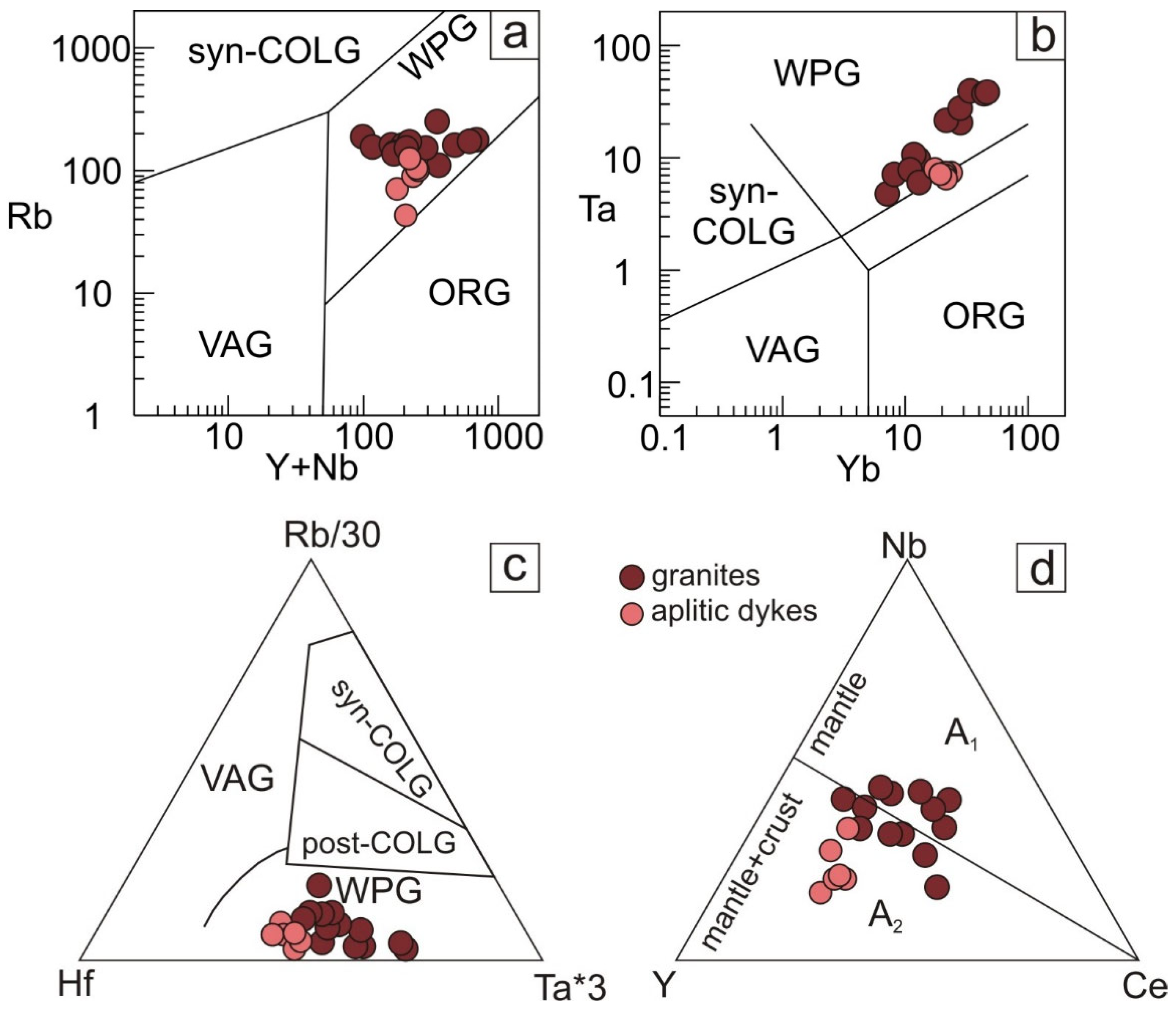
4.3. Whole-Rock Sr-Nd Isotopes
5. Discussion
5.1. Geochemical Evidences for A-Type Granitic Rocks and Emplacement Age
5.2. Origin of the Peralkaline A-Type Granites from Tannuola Terrane
5.3. Magma Source
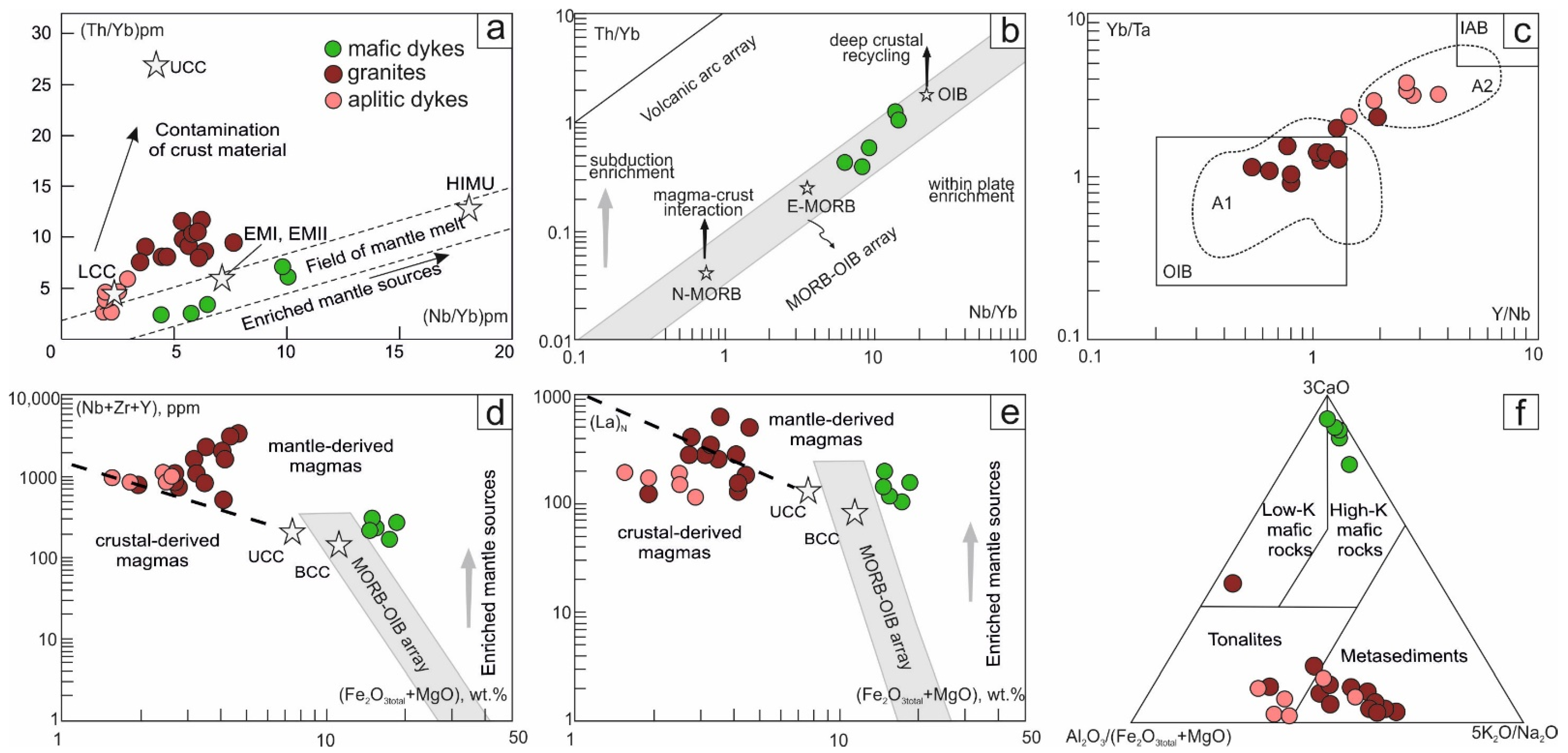
5.4. Tectonic Implication
5.5. Geodynamic Model
6. Conclusions
Author Contributions
Funding
Acknowledgments
Conflicts of Interest
References
- Papp, J.F. Tantalum. Minerals Yearbook 2015. V. I. Metals and Minerals. U.S. Geol. Surv. 2018, 76, 1–82. [Google Scholar]
- Schulz, K.J.; DeYoung, J.H.; Seal, R.R.; Bradley, D.C. (Eds.) Critical mineral resources of the United States—Economic and environmental geology and prospects for future supply. In U.S. Geological Survey Professional Paper; United States Government Publishing Office: Washington, DC, USA, 2017; 1802, pp. M1–M34. [Google Scholar]
- Bonin, B. A-type granites and related rocks: Evolution of a concept, problems and prospects. Lithos 2007, 97, 1–29. [Google Scholar] [CrossRef]
- Rudnick, R. Making continental crust. Nature 1995, 378, 571–578. [Google Scholar] [CrossRef]
- Eby, G.N. Chemical subdivision of the A-type granitoids:Petrogenetic and tectonic implications. Geology 1992, 20, 641–644. [Google Scholar] [CrossRef]
- Abdel-Karim, A.-A.; Azer, M.; Sami, M. Petrogenesis and tectonic implications of the Maladob ring complex in the South Eastern Desert, Egypt: New insights from mineral chemistry and whole-rock geochemistry. Geol. Rundsch. 2020, 110, 53–80. [Google Scholar] [CrossRef]
- Robinson, F.; Foden, J.; Collins, A. Geochemical and isotopic constraints on island arc, synorogenic, post-orogenic and anorogenic granitoids in the Arabian Shield, Saudi Arabia. Lithos 2015, 220-223, 97–115. [Google Scholar] [CrossRef]
- Papoutsa, A.; Pe-Piper, G.; Piper, D.J. Systematic mineralogical diversity in A-type granitic intrusions: Control of magmatic source and geological processes. GSA Bull. 2015, 128, 487–501. [Google Scholar] [CrossRef]
- Sengör, A.M.C.; Natalin, B.A.; Burtman, V.S. Evolution of the Altaid Tectonic Collage and Paleozoic crustal growth in Eurasia. Nature 1993, 364, 299–307. [Google Scholar] [CrossRef]
- Xiao, W.; Windley, B.F.; Sun, S.; Li, J.; Huang, B.; Han, C.; Yuan, C.; Sun, M.; Chen, H. A Tale of Amalgamation of Three Permo-Triassic Collage Systems in Central Asia: Oroclines, Sutures, and Terminal Accretion. Annu. Rev. Earth Planet. Sci. 2015, 43, 477–507. [Google Scholar] [CrossRef]
- Windley, B.F.; Alexeiev, D.; Xiao, W.; Kröner, A.; Badarch, G. Tectonic models for accretion of the Central Asian Orogenic Belt. J. Geol. Soc. 2007, 164, 31–47. [Google Scholar] [CrossRef]
- Xiao, W.J.; Windley, B.F.; Badararch, G.; Sun, S.; Li, J.; Qin, K.; Wang, Z. Paleozoic accretionary and convergent tectonics of the southern Altaids: Implications for the growth of central Asia. J. Geol. Soc. Lond. 2004, 161, 1–4. [Google Scholar] [CrossRef]
- Jahn, B.M. The Central Asian Orogenic Belt and growth of the contitental crust in the Phanerozoic. In Aspects of the Tectonic Evolution of China; Special Publications: London, UK, 2004; Volume 226, pp. 73–100. [Google Scholar]
- Dawei, H.; Shiguang, W.; Baofu, H.; Manyuan, J. Post-orogenic alkaline granites from China and comparisons with anorogenic alkaline granites elsewhere. J. Southeast Asian Earth Sci. 1996, 13, 13–27. [Google Scholar] [CrossRef]
- Jahn, B.-M.; Wu, F.; Chen, B. Granitoids of the Central Asian Orogenic Belt and continental growth in the Phanerozoic. Trans. R. Soc. Edinb. Earth Sci. 2000, 91, 181–193. [Google Scholar] [CrossRef]
- Su, H.-M.; Jiang, S.-Y.; Zhu, X.-Y.; Duan, Z.-P.; Huang, X.-K.; Zou, T. Magmatic-hydrothermal processes and controls on rare-metal enrichment of the Baerzhe peralkaline granitic pluton, inner Mongolia, northeastern China. Ore Geol. Rev. 2021, 131, 103984. [Google Scholar] [CrossRef]
- Kuzmin, M.; Yarmolyuk, V. Mantle plumes of Central Asia (Northeast Asia) and their role in forming endogenous deposits. Russ. Geol. Geophys. 2014, 55, 120–143. [Google Scholar] [CrossRef]
- Mongush, A.A.; Lebedev, V.I.; Kovach, V.P.; Sal’nikova, E.B.; Druzhkova, E.K.; Yakovleva, S.Z.; Plotkina, Y.V.; Zagornaya, N.Y.; Travin, A.V.; Serov, P.A. The tectonomagmatic evolution of structure-lithologic complexes in the Tannu–Ola zone, Tuva, in the Late Vendian–Early Cambrian (from geochemical, Nd isotope, and geochronological data). Russ. Geol. Geophys. 2011, 52, 503–516. [Google Scholar] [CrossRef]
- Rudnev, S.N.; Kovach, V.P.; Ponomarchuk, V.A. Vendian–Early Cambrian island-arc plagiogranitoid magmatism in the Altai–Sayan folded area and in the Lake Zone of western Mongolia (geochronological, geochemical, and isotope data). Russ. Geol. Geophys. 2013, 54, 1272–1287. [Google Scholar] [CrossRef]
- Vetrov, E.; Chernykh, A.; Babin, G. Early Paleozoic Granitoid Magmatism in the East Tannu-Ola Sector of the Tuvinian Magmatic Belt: Geodynamic Setting, Age, and Metallogeny. Russ. Geol. Geophys. 2019, 60, 492–513. [Google Scholar] [CrossRef]
- Vetrov, E.V.; Uvarov, A.N.; Vetrova, N.I.; Letnikov, F.A.; Vishnevskaya, I.A.; Zhimulev, F.I.; Andreeva, E.S.; Chervyakovskaya, M.V. Petrogenesis of Despen volcanogenic formations of the Middle-Late Ordovician volcano-plutonic association of the Tannuol Terrane (Southwest Tuva). Russ. Geol. Geophys. 2021, 62, 633–647. [Google Scholar] [CrossRef]
- Vetrov, E.; De Grave, J.; Vetrova, N.; Zhimulev, F.; Nachtergaele, S.; Van Ranst, G.; Mikhailova, P. Tectonic History of the South Tannuol Fault Zone (Tuva Region of the Northern Central Asian Orogenic Belt, Russia): Constraints from Multi-Method Geochronology. Minerals 2020, 10, 56. [Google Scholar] [CrossRef]
- Vorontsov, A.; Yarmolyuk, V.; Dril, S.; Ernst, R.; Perfilova, O.; Grinev, O.; Komaritsyna, T. Magmatism of the Devonian Altai-Sayan Rift System: Geological and geochemical evidence for diverse plume-lithosphere interactions. Gondwana Res. 2020, 89, 193–219. [Google Scholar] [CrossRef]
- Kozakov, I.K.; Didenko, A.N.; Azimov, P.Y.; Kirnozova, T.I.; Sal’Nikova, E.B.; Anisimova, I.V.; Erdenejargal, C. Geodynamic settings and formation conditions of crystalline complexes in the south Altai and south Gobi metamorphic belts. Geotectonics 2011, 45, 174–194. [Google Scholar] [CrossRef]
- Kuzmin, M.I.; Yarmolyuk, V.V. Plate tectonics andmantle plumes as a basis of deepseated Earth’s tectonic activity for the last 2 Ga. Russ. Geol. Geophys. 2014, 55, 120–143. [Google Scholar] [CrossRef]
- Sugorakova, A.M.; Nikiforov, A.V. Basic magmatism of Early Devonian rifting Tuvinian trough. Geosphere Res. 2016, 1, 85–103. [Google Scholar] [CrossRef][Green Version]
- Yarmolyuk, V.V.; Nikiforov, A.V.; Sal’Nikova, E.B.; Travin, A.V.; Kozlovskiy, A.; Kotov, A.B.; Shuriga, T.N.; Lykhin, D.A.; Lebedev, V.I.; Anisimova, I.V.; et al. Rare-metal granitoids of the Ulug-Tanzek deposit (Eastern Tyva): Age and tectonic setting. Dokl. Earth Sci. 2010, 430, 95–100. [Google Scholar] [CrossRef]
- Yarmolyuk, V.V.; Lykhin, D.A.; Kozlovsky, A.; Nikiforov, A.V.; Travin, A.V. Composition, sources, and mechanisms of origin of rare-metal granitoids in the Late Paleozoic Eastern Sayan zone of alkaline magmatism: A case study of the Ulaan Tolgoi massif. Petrology 2016, 24, 477–496. [Google Scholar] [CrossRef]
- Williams, I.S. U–Th–Pb Geochronology by IonMicroprobe. In Applications of Microanalytical Techniques to Understanding Mineralizing Processes; McKibben, M.A., Shanks, W.C., Ridley, W.I., Eds.; Society of Economic Geologists: Littleton, CO, USA, 1998; Volume 7, pp. 1–35. [Google Scholar]
- Black, L.P.; Kamo, S.L.; Allen, C.M.; Aleinikoff, J.N.; Davis, D.W.; Korsch, R.J.; Foudoulis, C. TEMORA 1: A new zircon standard for U-Pb geochronology. Chem. Geol. 2003, 200, 155–170. [Google Scholar] [CrossRef]
- Stacey, J.S.; Kramers, J.D. Approximation of terrestrial lead isotope evolution by a two-stage model. Earth Planet. Sci. Lett. 1975, 26, 207–221. [Google Scholar] [CrossRef]
- Vermeesch, P. IsoplotR: A free and open toolbox for geochronology. Geosci. Front. 2018, 9, 1479–1493. [Google Scholar] [CrossRef]
- Jenner, G.A.; Longerich, P.; Jackson, S.E.; Fryer, B.J. ICP-MS—A powerful tool for high-precision trace-element analysis in Earth sciences: Evidence from analysis of selected U.S.G.S. reference samples. Chem. Geol. 1990, 83, 133–148. [Google Scholar] [CrossRef]
- Bogomolov, E.S.; Guseva, V.F.; Turchenko, S.I. Mantle origin of the Pana Tundra layered mafic intrusion: Evidence from Sm–Nd and Rb–Sr data. Geochem. Int. 2002, 40, 855–859. [Google Scholar]
- Faure, G. Principles of Isotope Geology; John Wiley Sons Inc.: New York, NY, USA, 1986. [Google Scholar]
- De Paolo, D.J.; Linn, A.M.; Schubert, G. The continental crust age distribution: Methods of determining mantle separation ages fromSm-Nd isotopic data and application to the southwestern United States. J. Geophys. Res. 1991, 96, 2071–2088. [Google Scholar] [CrossRef]
- Belousova, E.; Griffin, W.; O’Reilly, S.Y.; Fisher, N. Igneous zircon: Trace element composition as an indicator of source rock type. Contrib. Miner. Pet. 2002, 143, 602–622. [Google Scholar] [CrossRef]
- Collins, W.J.; Beams, S.D.; White, A.J.R.; Chappell, B.W. Nature and origin of A-type granites with particular reference to southeastern Australia. Contrib. Miner. Pet. 1982, 80, 189–200. [Google Scholar] [CrossRef]
- Whalen, J.B.; Currie, K.L.; Chappell, B.W. A-type granites: Geochemical characteristics, discrimination and petrogenesis. Contrib. Mineral. Petrol. 1987, 95, 407–419. [Google Scholar] [CrossRef]
- Frost, B.R.; Barnes, C.G.; Collins, W.J.; Arculus, R.J.; Ellis, D.J.; Frost, C.D. A Geochemical Classification for Granitic Rocks. J. Pet. 2001, 42, 2033–2048. [Google Scholar] [CrossRef]
- Le Maitre, R.W.B.; Dudek, P.; Keller, A.; Lameyre, J.; Le Bas, J.; Sabine, M.J.; Zanettin, A.R. A classification of igneous rocks and glossary of terms: Recommendations of the International Union of Geological Sciences. Subcomm. Syst. Igneous Rocks 1989, 552, 3. [Google Scholar]
- Maniar, P.D.; Piccoli, P.M. Tectonic discrimination of granitoids. Geol. Soc. Am. Bull. 1989, 101, 635–643. [Google Scholar] [CrossRef]
- Watson, E.B.; Harrison, T.M. Zircon saturation revisited: Temperature and composition effects in a variety of crustal magma types. Earth Planet. Sci. Lett. 1983, 64, 295–304. [Google Scholar] [CrossRef]
- Sun, S.S.; McDonough, W.F. Chemical and isotopic systematics of oceanic basalts: Implications for mantle composition and processes. In Magmatism in the Ocean Basin; Geological Society Special Publication: London, UK, 1989; Volume 42, pp. 313–345. [Google Scholar]
- McDonough, W.F.; Sun, S.-S. The composition of the Earth. Chem. Geol. 1995, 120, 223–253. [Google Scholar] [CrossRef]
- Pearce, J.A.; Harris, N.B.W.; Tindle, A.G. Trace Element Discrimination Diagrams for the Tectonic Interpretation of Granitic Rocks. J. Pet. 1984, 25, 956–983. [Google Scholar] [CrossRef]
- Harris, N.B.W.; Pearce, J.A.; Tindle, A.G. Geochemical characteristics of collision-zone magmatism. In Geological Society; Special Publications: London, UK, 1986; Volume 19, pp. 67–81. [Google Scholar] [CrossRef]
- Chappell, B.W.; White, A.J.R. Two constrasting granite types. Pac. Geol. 1974, 8, 173–174. [Google Scholar]
- Miller, C.F.; McDowell, S.M.; Mapes, R.W. Hot and cold granites? Implications of zircon saturation temperatures and preservation of inheritance. Geology 2003, 31, 529–532. [Google Scholar] [CrossRef]
- Jiang, Y.-H.; Jiang, S.-Y.; Dai, B.-Z.; Liao, S.-Y.; Zhao, K.-D.; Ling, H.-F. Middle to late Jurassic felsic and mafic magmatism in southern Hunan province, southeast China: Implications for a continental arc to rifting. Lithos 2009, 107, 185–204. [Google Scholar] [CrossRef]
- Yang, J.; Wu, F.; Chung, S.; Wilde, S.A.; Chu, M. A hybrid origin for the Qianshan A-type granite, northeast China: Geochemical and Sr–Nd–Hf isotopic evidence. Lithos 2006, 89, 89–106. [Google Scholar] [CrossRef]
- Zhao, K.D.; Jiang, S.Y.; Yang, S.Y.; Dai, B.Z.; Lu, J.J. Mineral chemistry, trace elements and Sr–Nd–Hf isotope geochemistry and petrogenesis of Cailing and Furong granites and mafic enclaves from the Qitianling batholith in the Shi-Hang zone, South China. Gondwana Res. 2012, 22, 310–324. [Google Scholar] [CrossRef]
- Litvinovsky, B.A.; Jahn, B.M.; Zanvilevich, A.N.; Saunders, A.; Poulain, S.; Kuzmin, D.V.; Reichow, M.K.; Titov, A.V. Petrogenesis of syenite–granite suites from the Bryansky Complex (Transbaikalia, Russia): Implications for the origin of A-type granitoid magmas. Chem. Geol. 2002, 189, 105–133. [Google Scholar] [CrossRef]
- Martin, R. A-type granites of crustal origin ultimately result from open-system fenitization-type reactions in an extensional environment. Lithos 2006, 91, 125–136. [Google Scholar] [CrossRef]
- Saunders, A.D.; Storey, M.; Kent, R.W.; Norry, M.J. Consequences of plume-lithosphere interactions. In Magmatism and the Causes of Continental Break-up; Storey, B.C., Alabaster, T., Pankhurst, R.J., Eds.; Geological Society: London, UK, 1992; Volume 68, pp. 41–60. [Google Scholar] [CrossRef]
- Lassiter, J.C.; DePaolo, D.J. Plume/Lithosphere Interaction in the Generation of Continental and Oceanic Flood Basalts: Chemical and Isotopic Constraints. Geophys. Monogr. -Am. Geophys. Union 2013, 100, 335–355. [Google Scholar] [CrossRef]
- Wedepohl, K.H. The composition of the continental crust. Geochim. et Cosmochim. Acta 1995, 59, 1217–1232. [Google Scholar] [CrossRef]
- Laurent, O.; Martin, H.; Moyen, J.F.; Doucelance, R. The diversity and evolution of late-Archean granitoids: Evidence for the onset of ‘modern-style’ plate tectonics between 3.0 and 2.5 Ga. Lithos 2014, 205, 208–235. [Google Scholar] [CrossRef]
- Shellnutt, J.G.; Wang, C.Y.; Zhou, M.-F.; Yang, Y. Zircon Lu–Hf isotopic compositions of metaluminous and peralkaline A-type granitic plutons of the Emeishan large igneous province (SW China): Constraints on the mantle source. J. Southeast Asian Earth Sci. 2009, 35, 45–55. [Google Scholar] [CrossRef]
- Rudnick, R.L.; Gao, S. Composition of the Continental Crust. In Treatise on Geochemistry; Rudnick, R.L., Holland, H.D., Turekian, K.K., Eds.; Elsevier: Amsterdam, The Netherlands, 2003; Volume 3, pp. 1–64. [Google Scholar]
- Wilson, M. Igneous Petrogenesis: A Global Tectonic Approach; Unwyn Hyman: London, UK, 1989. [Google Scholar]
- Zhang, X.; Zhao, G.; Eizenhöfer, P.R.; Sun, M.; Han, Y.; Hou, W.; Liu, D.; Wang, B.; Liu, Q.; Xu, B.; et al. Tectonic transition from Late Carboniferous subduction to Early Permian post-collisional extension in the Eastern Tianshan, NW China: Insights from geochronology and geochemistry of mafic–intermediate intrusions. Lithos 2016, 256-257, 269–281. [Google Scholar] [CrossRef]
- Taylor, S.R.; McLennan, S.M. The Continental Crust: Its Composition and Evolution: An Examination of the Geochemical Record Preserved in Sedimentary Rocks; Blackwell Scientific: Oxford, UK, 1985. [Google Scholar]
- Condie, K.C. Mantle Plumes and their Record in Earth History. Cambridge University Press: Cambridge, UK, 2001. [Google Scholar] [CrossRef]
- Pearce, J.A. Geochemical fingerprinting of oceanic basalts with applications to ophiolite classification and the search for Archean oceanic crust. Lithos 2008, 100, 14–48. [Google Scholar] [CrossRef]
- Altunkaynak, Ş.; Dilek, Y.; Genc, C.S.; Sunal, G.; Gertisser, R.; Furnes, H.; Foland, K.A.; Jing-Sui, Y. Spatial, temporal and geochemical evolution of Oligo-Miocene granitoid magamtism in wester Anatolia, Turkey. Gondwana Res. 2012, 21, 961–986. [Google Scholar] [CrossRef]
- Bi, J.-H.; Ge, W.-C.; Yang, H.; Wang, Z.-H.; Tian, D.-X.; Liu, X.-W.; Xu, W.-L.; Xing, D.-H. Geochemistry of MORB and OIB in the Yuejinshan Complex, NE China: Implications for petrogenesis and tectonic setting. J. Southeast Asian Earth Sci. 2017, 145, 475–493. [Google Scholar] [CrossRef]
- Li, X.H.; Chen, Z.G.; Liu, D.Y.; Li, W.X. Jurassic gabbro-granite-syentite suites from southern Jiangxi Province, SE China: Age, origin and tectonic significance. Int. Geol. Rev. 2003, 45, 898–921. [Google Scholar] [CrossRef]
- Eby, G. The A-type granitoids: A review of their occurrence and chemical characteristics and speculations on their petrogenesis. Lithos 1990, 26, 115–134. [Google Scholar] [CrossRef]
- Zhang, H.F.; Parrish, R.; Zhang, L.; Xu, W.C.; Yuan, H.L.; Gao, S.; Crowley, Q.G. A-type granite and adakitic magmatism association in Songpan-Ganzi fold belt, eastern Tibetan Plateau: Implication for lithospheric delamination. Lithos 2007, 97, 323–335. [Google Scholar] [CrossRef]
- Davies, J.H.; Von Blanckenburg, F. Slab breakoff: Amodel of lithosphere detachment and its test in the magmatism and deformation of collisional orogens. Earth Planet. Sci. Lett. 1995, 129, 85–102. [Google Scholar] [CrossRef]
- Altunkaynak, Ş. Collision-driven slab break offmagmatismin Northwestern Anatolia, Turkey. J. Geol. 2007, 115, 63–82. [Google Scholar] [CrossRef]
- Kuzmin, M.I.; Yarmolyuk, V.V.; Kravchinsky, V.A. Phanerozoic hot spot traces and paleogeographic reconstructions of the Siberian continent based on interaction with the African large low shear velocity province. Earth-Science Rev. 2010, 102, 29–59. [Google Scholar] [CrossRef]
- Ernst, R.E.; Rodygin, S.A.; Grinev, O.M. Age correlation of Large Igneous Provinces with Devonian biotic crises. Glob. Planet. Chang. 2019, 185, 103097. [Google Scholar] [CrossRef]
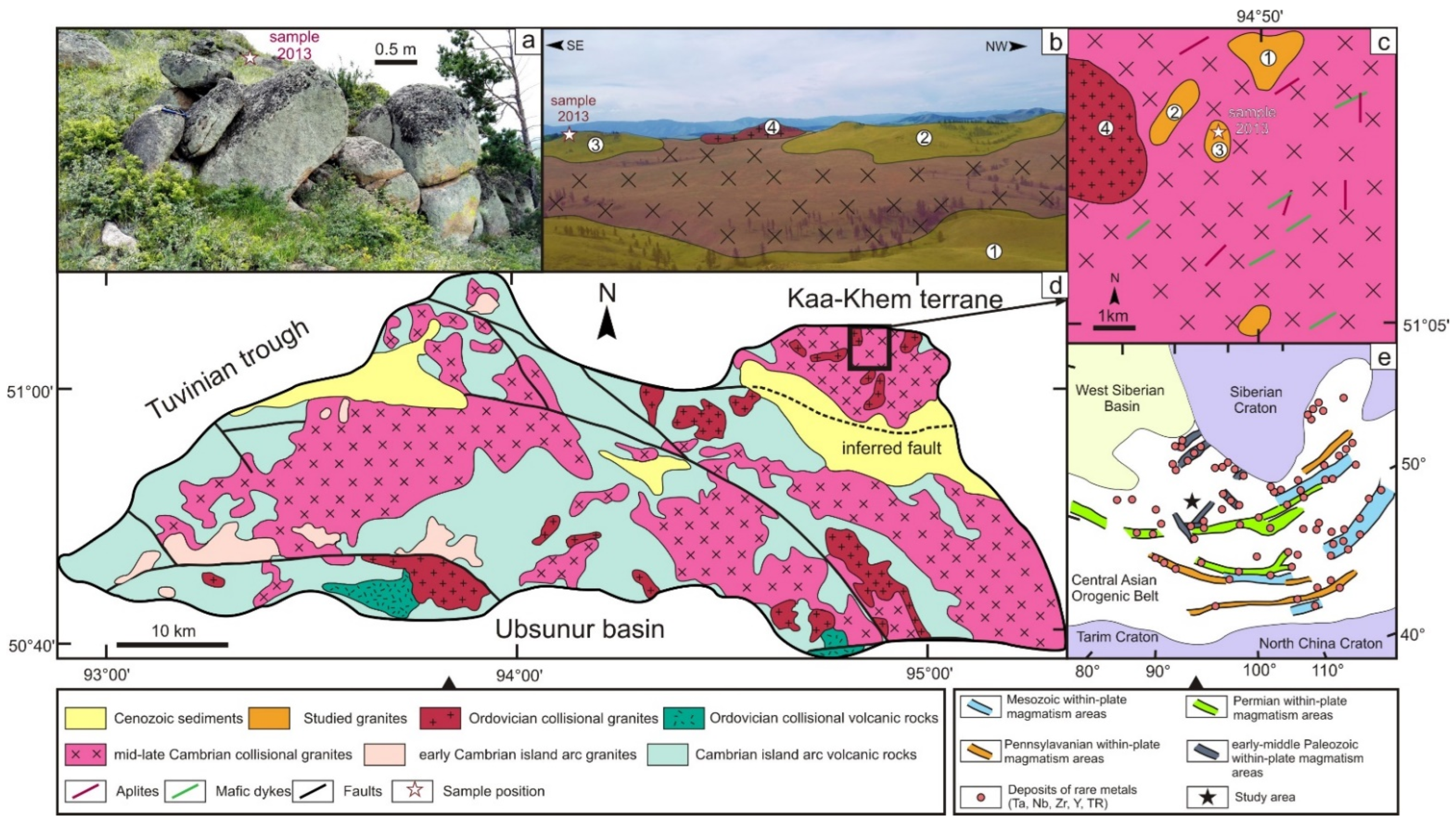
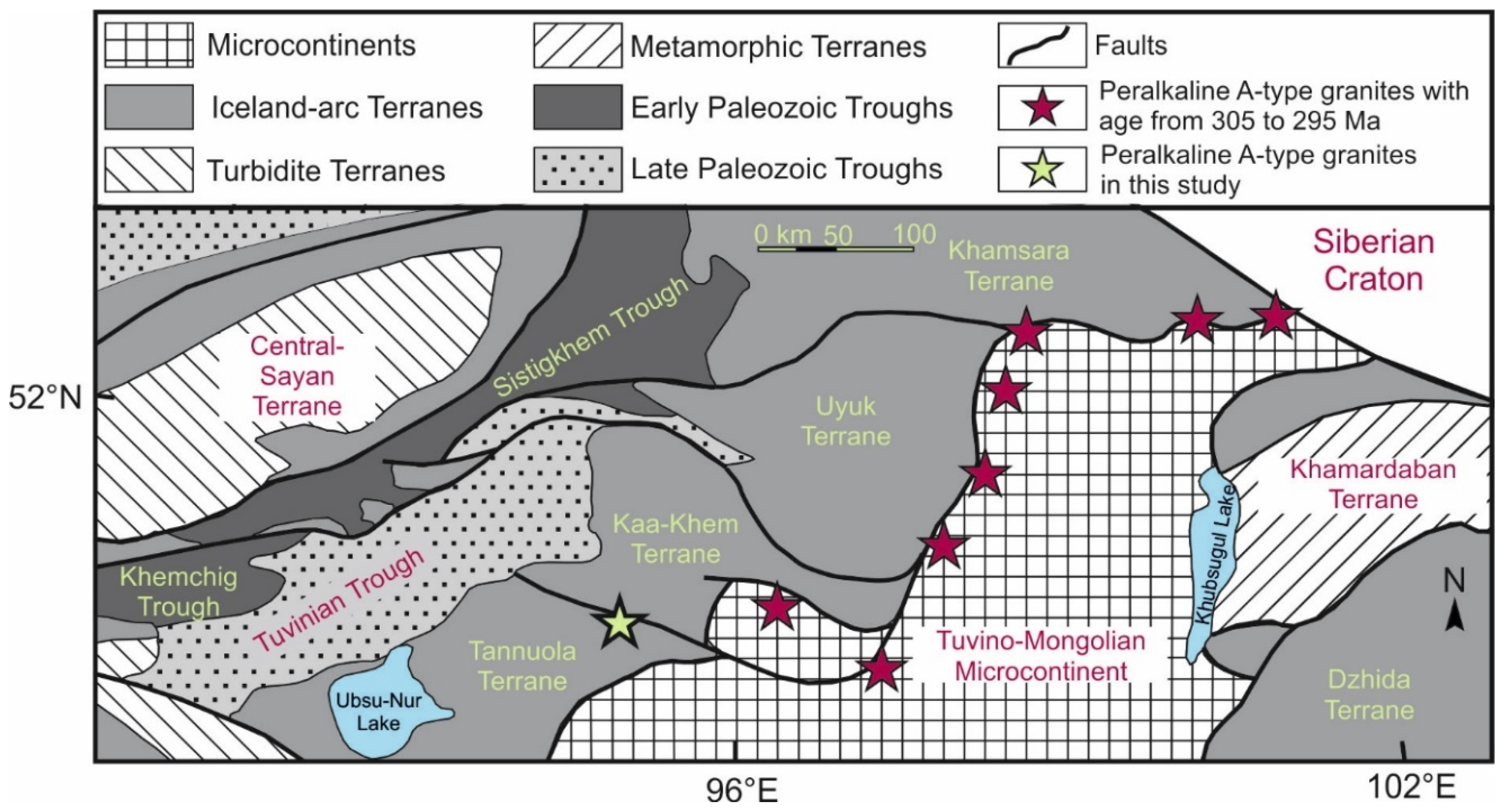

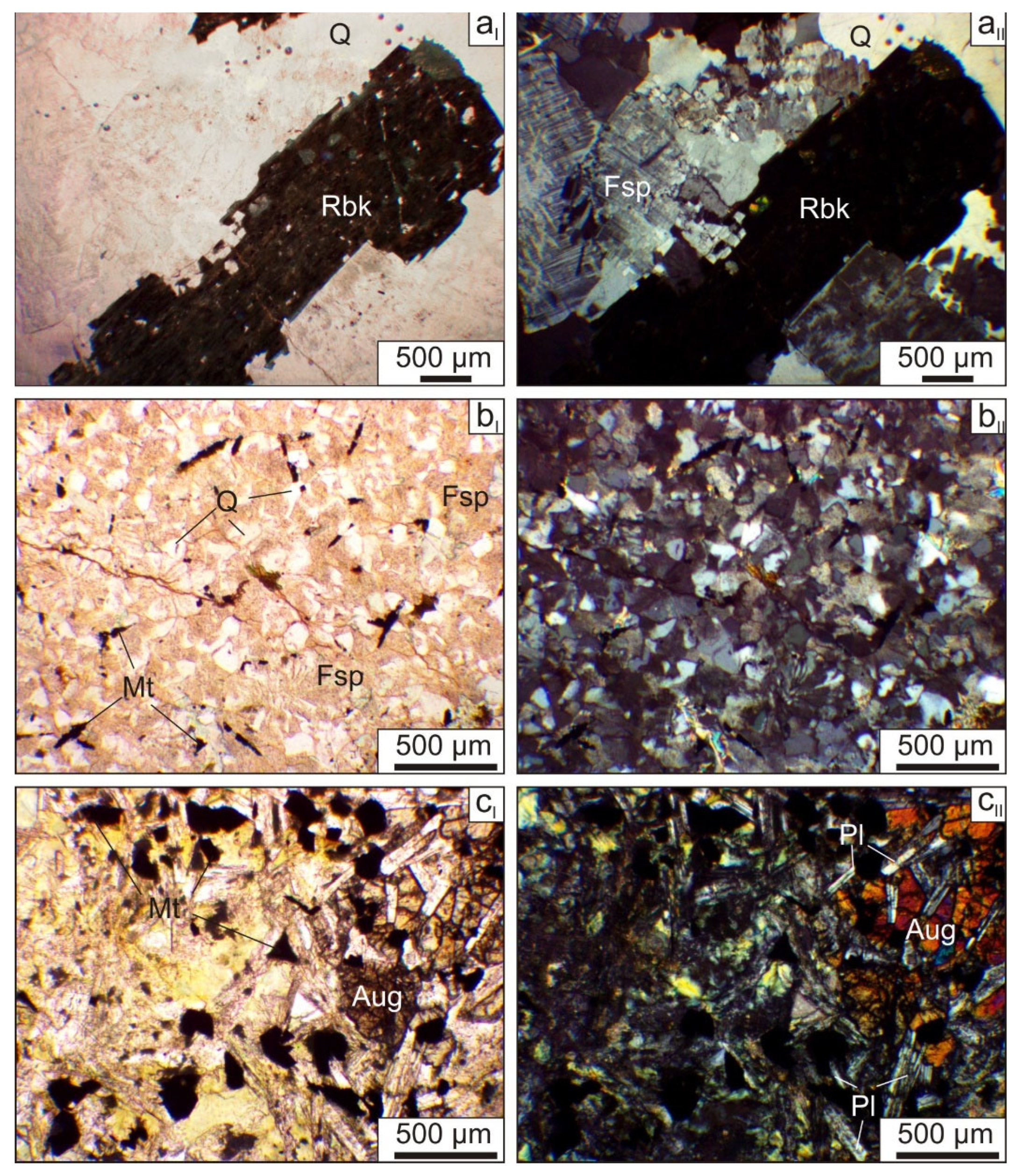
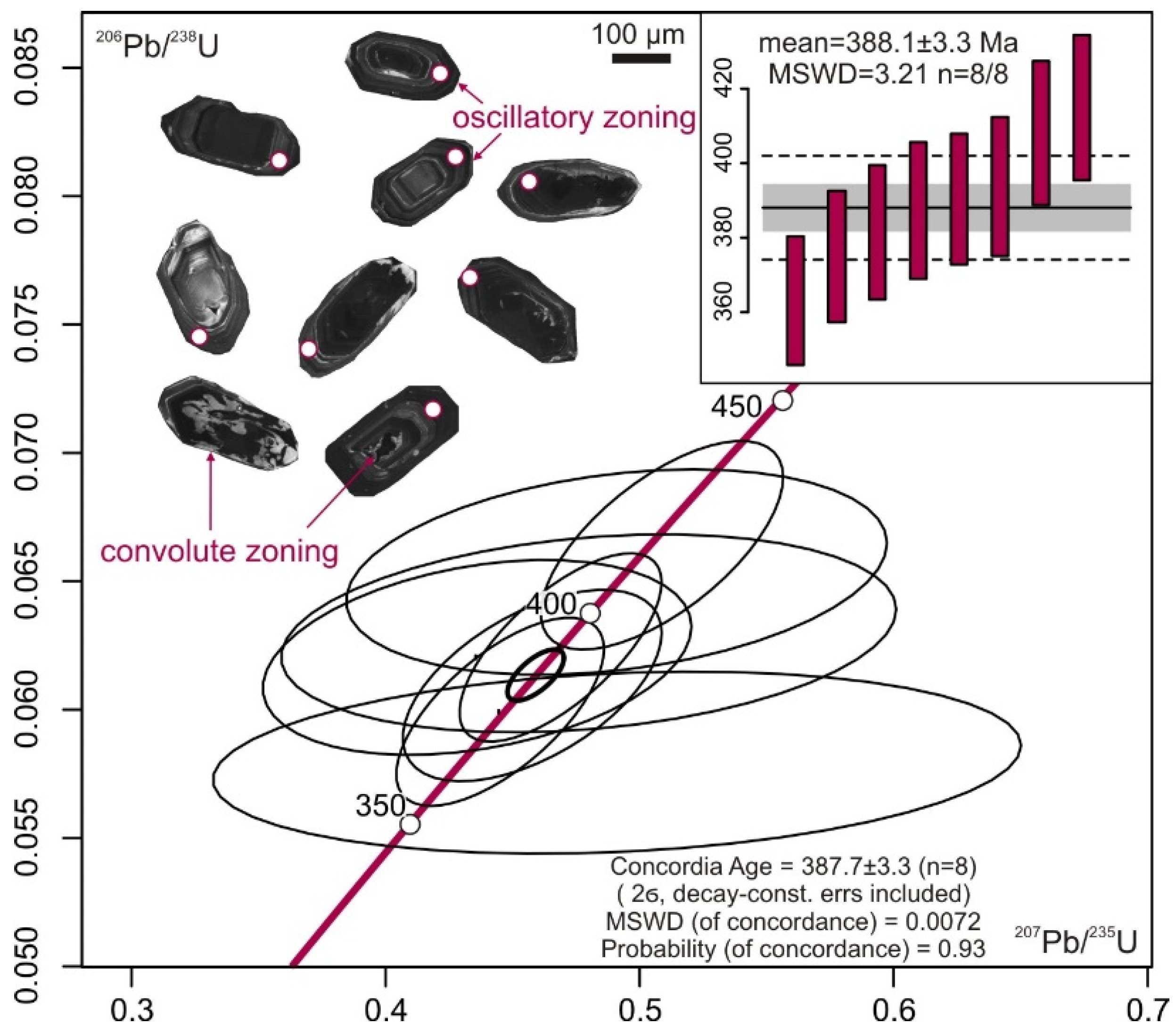
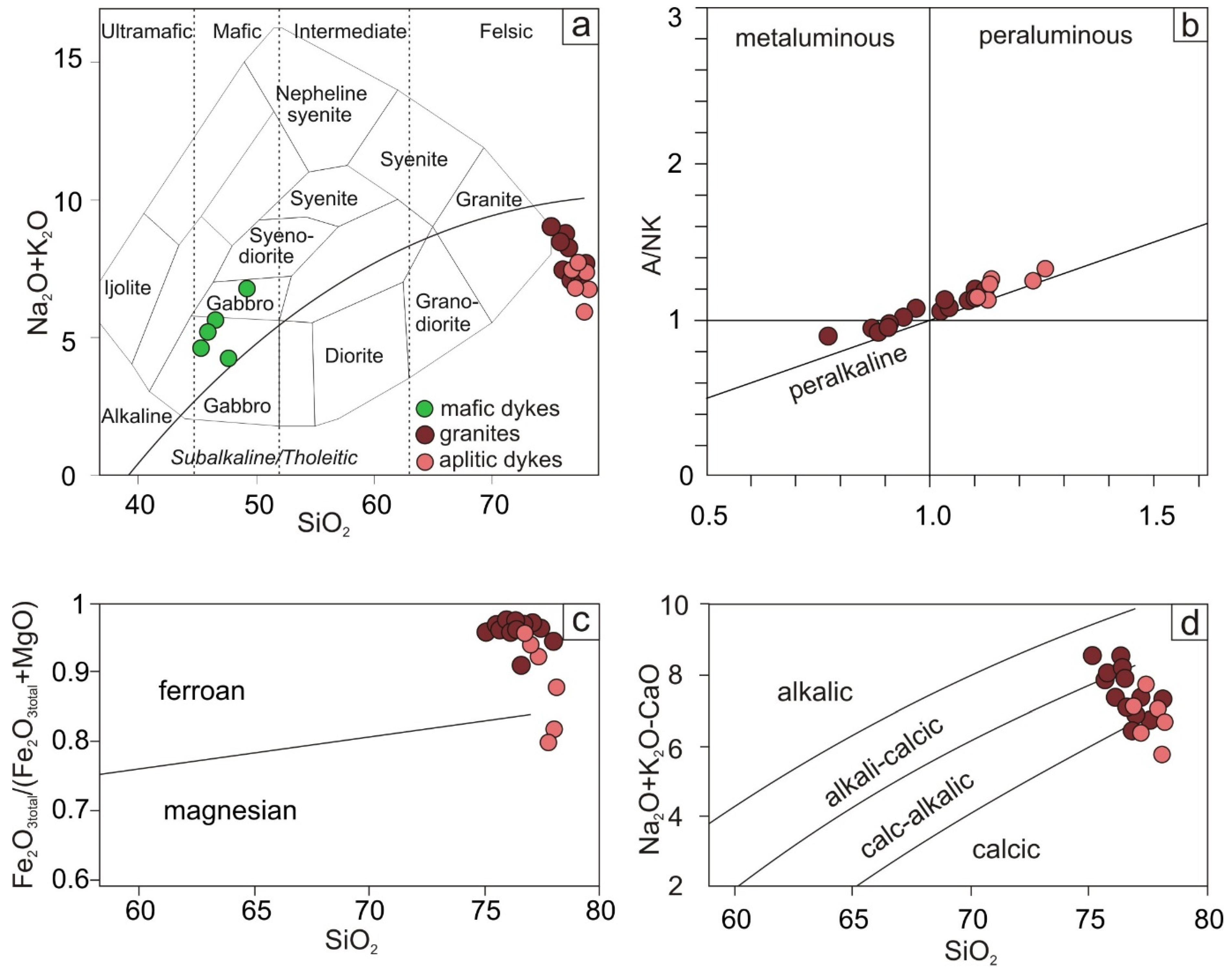
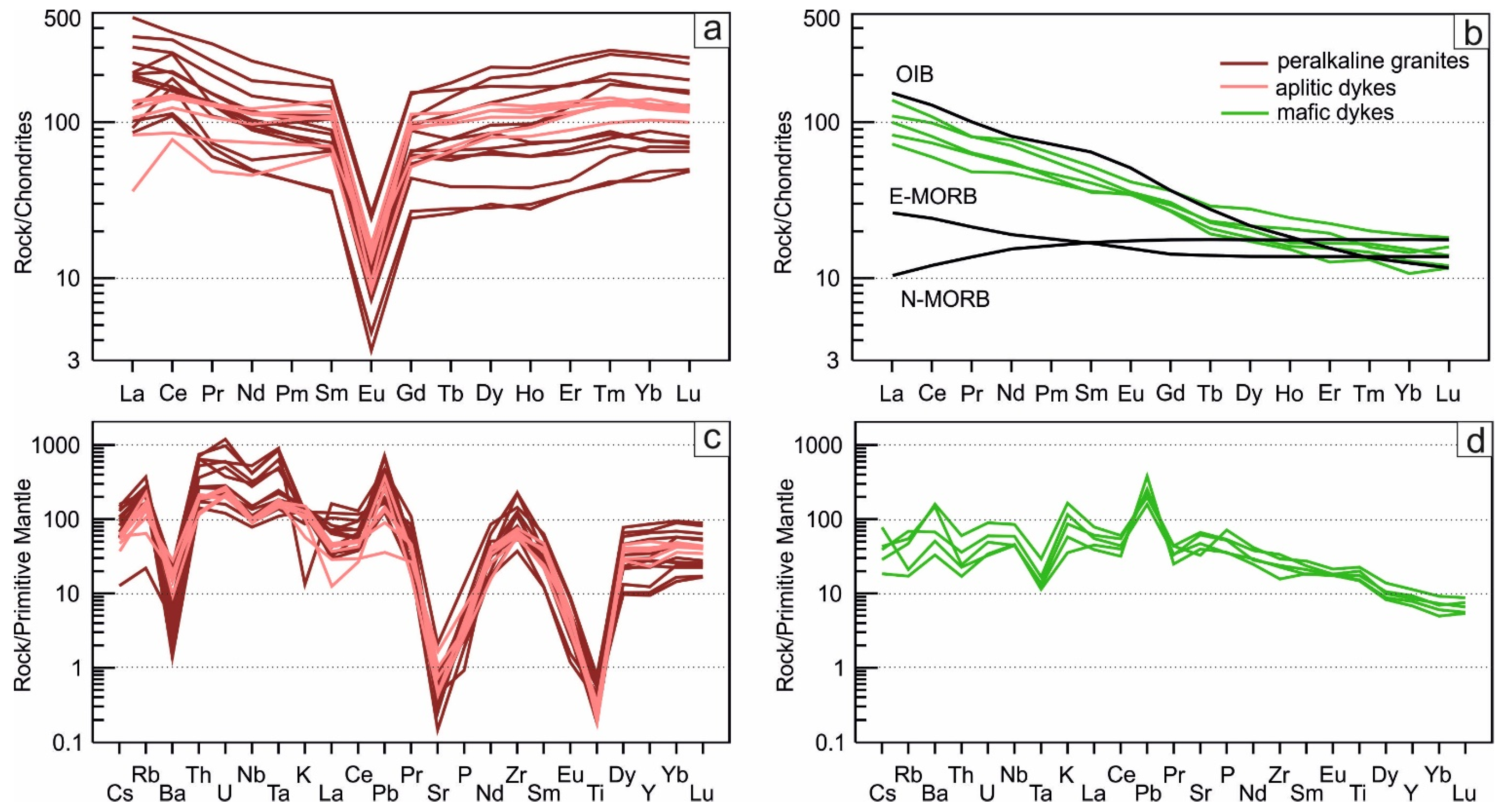
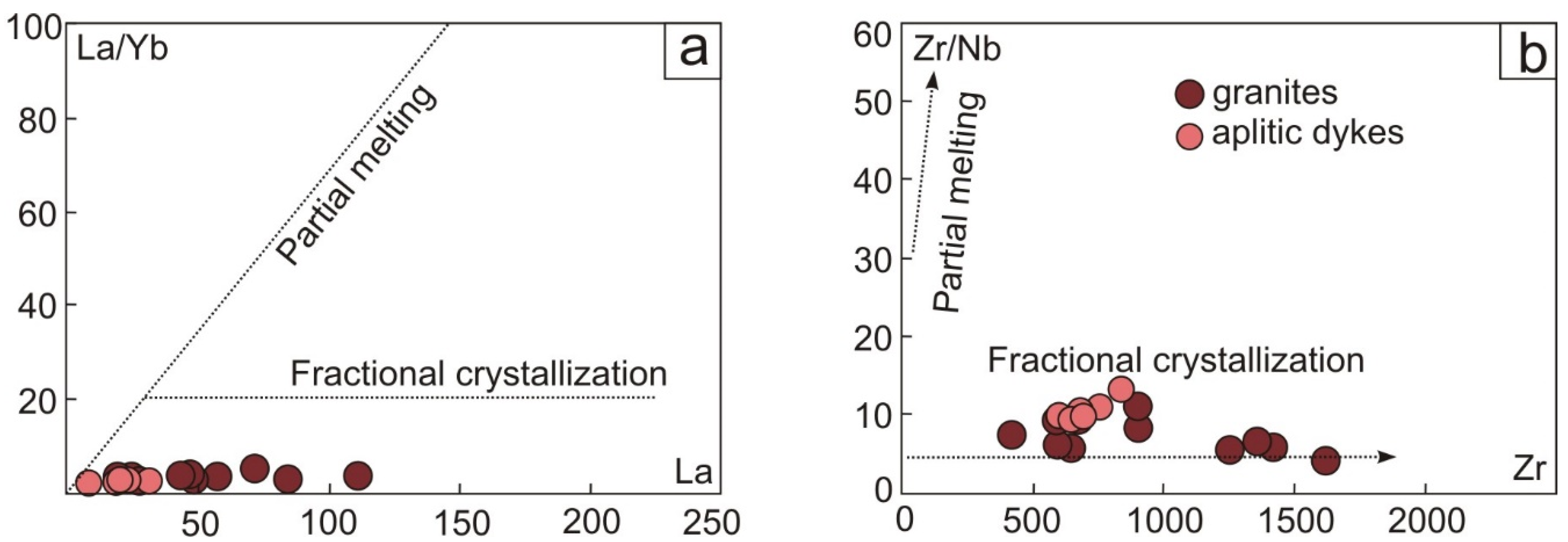
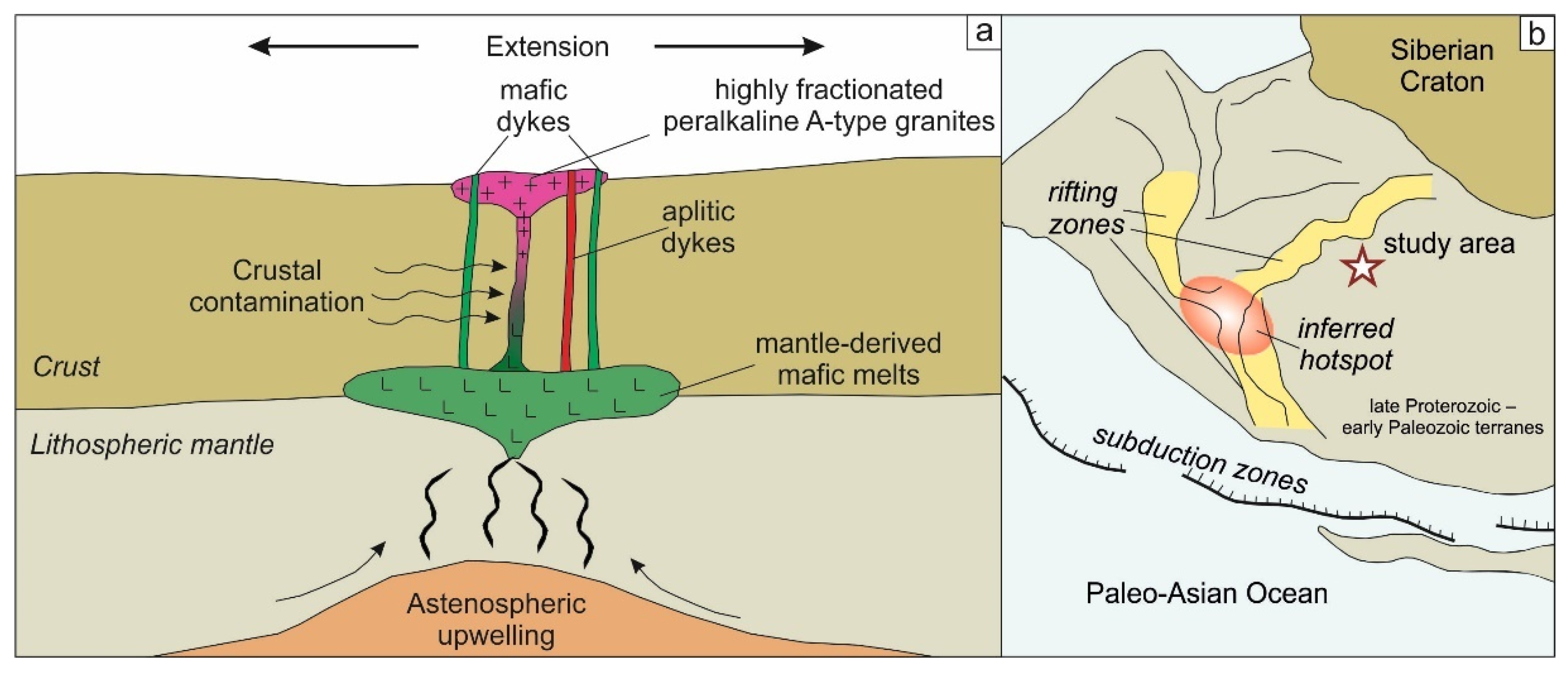
| Sample | 2013 | 2012-2 | 2010 | 2011 |
|---|---|---|---|---|
| Rb (ppm) | 134.1 | 189.5 | 144.8 | 151.9 |
| Sr (ppm) | 14.0 | 5.2 | 13.0 | 8.0 |
| 87Rb/86Sr | 28.5 | 112.9 | 31.9 | 57.0 |
| ±2 σ | 0.2850 | 1.1291 | 0.3186 | 0.5702 |
| 87Sr/86Sr | 0.867348 | 1.357252 | 0.886572 | 1.036868 |
| ±2 σ | 0.000009 | 0.000009 | 0.000009 | 0.000007 |
| (87Sr/86Sr)0 | 0.867348 | 1.357252 | 0.886572 | 1.036868 |
| Sm (ppm) | 9.66 | 19.35 | 12.29 | 2.78 |
| Nd (ppm) | 36.06 | 62.30 | 43.90 | 11.31 |
| 147Sm/144Nd | 0.16200 | 0.15430 | 0.16910 | 0.14860 |
| ±2 σ | 0.00016 | 0.00015 | 0.00017 | 0.00015 |
| 143Nd/144Nd | 0.512860 | 0.512833 | 0.512855 | 0.512851 |
| ±2 σ | 0.000004 | 0.000004 | 0.000005 | 0.000006 |
| (143Nd/144Nd)0 | 0.512860 | 0.512833 | 0.512855 | 0.512851 |
| ±2σ | 0.000027 | 0.000019 | 0.000006 | 0.000010 |
| εNd(t) | 6.06 | 5.91 | 5.61 | 6.55 |
| T(DM1), Ma | 1060 | 1040 | 1180 | 940 |
| T(DM2), Ma | 560 | 580 | 610 | 520 |
Publisher’s Note: MDPI stays neutral with regard to jurisdictional claims in published maps and institutional affiliations. |
© 2022 by the authors. Licensee MDPI, Basel, Switzerland. This article is an open access article distributed under the terms and conditions of the Creative Commons Attribution (CC BY) license (https://creativecommons.org/licenses/by/4.0/).
Share and Cite
Vetrov, E.V.; Pikhutin, E.A.; Vetrova, N.I. Geochemical Constraints on Petrogenesis and Tectonics of the Middle Devonian Granitic and Coeval Mafic Magmatism from the Tannuola Terrane (Northern Central Asian Orogenic Belt). Minerals 2022, 12, 1282. https://doi.org/10.3390/min12101282
Vetrov EV, Pikhutin EA, Vetrova NI. Geochemical Constraints on Petrogenesis and Tectonics of the Middle Devonian Granitic and Coeval Mafic Magmatism from the Tannuola Terrane (Northern Central Asian Orogenic Belt). Minerals. 2022; 12(10):1282. https://doi.org/10.3390/min12101282
Chicago/Turabian StyleVetrov, Evgeny V., Evgeny A. Pikhutin, and Natalia I. Vetrova. 2022. "Geochemical Constraints on Petrogenesis and Tectonics of the Middle Devonian Granitic and Coeval Mafic Magmatism from the Tannuola Terrane (Northern Central Asian Orogenic Belt)" Minerals 12, no. 10: 1282. https://doi.org/10.3390/min12101282
APA StyleVetrov, E. V., Pikhutin, E. A., & Vetrova, N. I. (2022). Geochemical Constraints on Petrogenesis and Tectonics of the Middle Devonian Granitic and Coeval Mafic Magmatism from the Tannuola Terrane (Northern Central Asian Orogenic Belt). Minerals, 12(10), 1282. https://doi.org/10.3390/min12101282





